Traveling in Myanmar
Traveling through Myanmar, the country better known as Burma
By Edda Ehrke
February 18, 2007
Edda Ehrke is traveling around southeast Asia. In this installment she visits Myanmar.
The recent history of Myanmar is rather grim. After gaining independence from the British in 1948, the country suffered a series of military takeovers, and has basically been under the dictatorship of a military junta for the past 50 years. At several points during this time, the people have taken to the streets to peacefully protest the military regime. The last major fight for democracy occurred in 1988, and climaxed with the first democratically held election since independence. The National League for Democracy (NLD), spearheaded by the charismatic Aung San Suu Kyi, won by an overwhelming 84% of the vote. Sadly, regardless of their promises, the military junta had no intention of relinquishing their power, and imprisoned the major leaders of the NLD.
The Myanmar government violates basic human rights such as freedom of assembly and freedom of speech (all forms of media are censored). Their political prisoners, in addition to not having access to a fair trial or basic health care, are often tortured and their families pressured. The government continues to use forced labor (including women & children) to build its highways and public buildings. The government is responsible for the extreme poverty and suffering of its own people. Despite being one of the richest countries in SE Asia in resources (oil, teak, gems), Myanmar has the poorest people. Their economic growth is at 21% (China’s is 11% for comparison) – but this “prosperity” is not see by the vast majority. Inversely, with inflation at 50% per year, the people are getting poorer and poorer. The situation is heartbreaking.
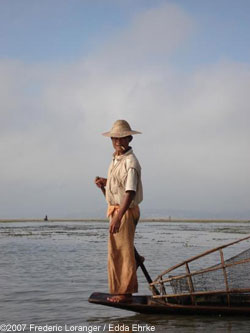 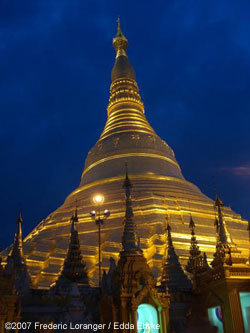
Inle Lake (top), Shwedagon Paya at night (bottom). Photos by Edda Ehrke |
We thought carefully before embarking on a trip to Myanmar. The USA, Canada and Europe have a total economic embargo on Myanmar and discourage people from traveling there. While we did not want to support the atrocious government, we were interested in seeing for ourselves what is really happening there. We also knew that by making careful choices about where we spent our money, we were putting the majority of our sought-after US dollars in the hands of the local people.
As our plane circled over Yangon (formerly known as Rangoon), we could see that this was the land of golden pagodas. The Burmese remain devote Buddhists, following a strain of Theravada Buddhism that has been virtually unchanged since it was first brought to Myanmar from India (about 300 BC). We have never seen so many Buddhist payas (or stupas) in our travels! By far the most magnificent was the crown jewel of Yangon – the Shwedagon Paya. The atmosphere surrounding this immense monument really becomes magical at nightfall, when hundreds of Burmese come to pray and light thousand of candles at the base of the golden stupa. The rest of Myanmar’s capital city quite paled in comparison – polluted beyond belief, with open gutters and urban decay that revile the streets of Delhi. The once-magnificent colonial buildings, reminders of its former glory, are in a state of decomposition. These were our first glimpses of the utter neglect of the public spaces and society.
Continuing east from Yangon, we took a couple of days to explore the towns of Bago and Kyaiktiyo. Bago was once a royal capital and important trading center, but is now known for its numerous and huge reclining Buddhas. One morning, we rose early to walk with over 500 monks as they went asking for alms. We also visited a small temple to get blessed by an enormous hundred-year-old boa constrictor that is believed to possess extraordinary powers. We finished with a visit to a cheroot “factory”, where women (and several children) hand-roll Burmese cigars with extreme dexterity. Each woman rolls about 1000 cheroots per day, earning a daily wage of less than $1.
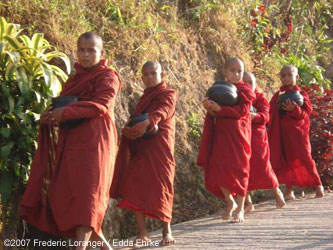 Monks at Kyaiktiyo. Photo by Edda Ehrke |
Kyaiktiyo is an important pilgrimage destination for Buddhists. A giant boulder painted in gold, on top of which a stupa was constructed, it is believed to balance on the cliff because of spiritual powers. It is also known as the “Golden Rock”. We woke before dawn to catch a ride up the mountain, and were packed like cattle in the back of a big truck, squeezed amongst the pilgrims. Crazily racing up the mountain, our companions cheered as we veered through each curve. We climbed the remainder of the way by foot, much entertained by the colorful parade of pilgrims: wealthy Japanese being carried up by porters, saffron robed monks, children with their faces prettily painted with thanaka (a traditional Burmese make-up/sunscreen derived from bark). Our view of the Golden Rock was a bit anti-climatic, as it was surrounded by bamboo scaffolding, being re-gilded by the monks of a nearby monastery. As it turned out, it was the journey itself, and not the destination, that was most memorable.
Then we had a somewhat harrowing mini-adventure trying to venture south to a town called Pahan. Basically, this involved us stubbornly refusing a ride on a pickup (because we thought they had quadrupled the going rate), waiting 10 hours for a bus that never came, deciding to ditch Pahan and head north, and getting a ride on a truck smuggling contraband. No we are not joking. This IS Myanmar after all.
After this exciting experience, we decided to splurge for a “deluxe” air-con bus for our overnight journey to the town of Kalaw, in Shan state. This ride turned out into something of a mild nightmare, as our “deluxe” bus was not so deluxe – in fact it started smoking within an hour of our journey and the air-con got shut off as the engine began to overheat. Sweat began to poor down Frederic’s sad face, which didn’t brighten as his diarrhea began in the middle of the night (you should’ve seen him stopping the bus in a panic and crouched down in a ditch). And the road… we were on the trans-Myanmar highway and it was little more than a pothole-filled dirt road. We have never been so rocked around in our life – it was beyond belief. Needless to say, we didn’t get a lot of sleep that night!
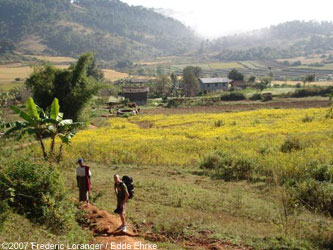 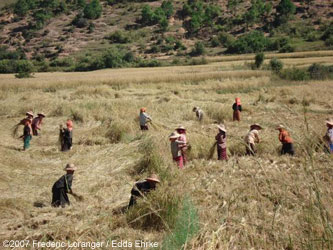 Hiking in Burma (top), Rice harvest (bottom). Photos by Edda Ehrke |
We arrived blurry eyed the following morning in Kalaw. This quiet, charming town is surrounded by mountains and blessed with cool, clean air. Kalaw has a colorful local market every 5 days, where people from all the surrounding villages come to sell their wares. It is in Kalaw where we began a 3-day trek to Inle Lake, a wonderful journey through spectacular mountains and valleys. The countryside was decked in all its glory – wildflowers blossoming in colorful profusion, the fields of rice and wheat lush and ready for harvest. We just fell in love with the people we met along the way – such warm smiles and heartfelt welcome.
Amongst our many interactions with the villagers we met, one of our most memorable was an elderly monk who was friends with our guide. This man had a wonderful presence and was fluent in four local dialects, in addition to Burmese and Pali (the official language of Buddhist scripture). He read to us from old religious scrolls and blessed us for a safe journey.
We visited several local schools and handed out some writing supplies we had brought as gifts. With the exception of schools that have been built by NGOs, the schools were in pitiful condition with walls literally crumbling down. The government provides inadequate funds to rural schools and villagers are left to provide the salary for teachers (about $25 per month). The children are pretty cheerful though – it was entertaining to hear how they yell out their lessons at the top of their lungs! At one school Frederic gave a demo on the mechanics of our water filter, as both teachers and children looked on with open-mouthed awe.
We spent one night in a village, sleeping on the floor in a bamboo hut, and one night in an old monastery. The head abbot was away the night that we visited the monastery, and boy-oh-boy, how the young novices did celebrate! We had such fun observing the unabashed joy that this bit of freedom created in the young monks. One little one danced around his broom as he swept, Frederic caught a group of novices at an early morning “gambling” session, and their pre-dawn prayers were preformed several hours late.
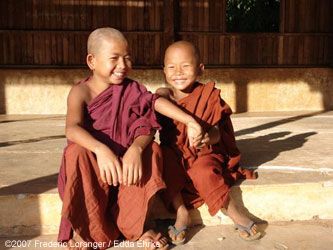 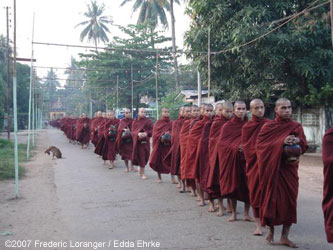 Young monks (top), Monks in Bago (bottom). Photos by Edda Ehrke |
In Burma, all males spend time in a monastery, at least twice in their life (one in childhood, and the other after the age of 20). Despite the rigors associated with monastery life, we were left without doubt that these young novices were quite happy. In a society where formal education is poor, the monastery provides these boys with not only discipline and an education, but also food and shelter when their families may have difficulty doing so.
During our trek, we had a lot of opportunity to speak about Burmese politics with our guide, a highly intelligent and gentle-mannered man of 64. “Joseph” told us the sad story of how he and countless others have suffered under a half century of military rule. Out of fear, “Joseph” did not go to university because of the crackdown and killings of university students in the ’60s. During the ’80s the government decided to “modernize” the country, and he was forced to sell his ancestral home, a traditional teak house, for almost nothing and move to the outskirts of his town, going into debt to build a new “modern” house. Many Burmese were hard hit in during this time when the government decided, literally overnight, to make certain currency notes obsolete (because the numbers were considered “unlucky”). For many Burmese, their life savings became obsolete, and many women and children fled to Thailand to work in the sex industry in order to survive. The stories continue. Our talks with “Joseph” were very moving, his pain and anger at what the government has done to his country and people so heartfelt. He told us that he and many people were willing to die for democracy, this with tears in his eyes. He said that he wished the USA had chosen to liberate Myanmar instead of Iraq. We didn’t have the heart to tell him that the US government was not exactly the “freedom fighters” that he and many Burmese imagined. Needless to say, we were left in a somber mood at the trek’s conclusion – a lot to think about.
On the third day we arrived in Inle Lake, which locals call “a sea between mountains”. The lake is indeed vast, and supports countless villages that etch out a rich existence from its depths. The houses, pagodas, and monasteries are built on stilts, and dugout canoes are the mode of transport – life surrounded by water. Apart from fish, villagers subsist on aquaculture – tomatoes and squash grown on small islands of hyacinth and fertilized with weeds dredged from the lake. Due to the lake’s great tourist appeal, many villagers have also set up a variety of cottage industries – silk weaving, silver making, metal forgery, etc. Lake Inle is especially picturesque in the early morning, as the mountains rise out of the mist and the sunshine illuminates the locals as they serenely paddle across the glassy lake, going about their day.
An 11-hour ride in a mini-bus, squeezed into a seat a foot wide, surrounded by cargo and 40 merry villagers, we made the memorable journey from Inle Lake to Bagan, in central Myanmar. For a period of about 200 years (until the end of the 13th century), Bagan was the richest and most powerful kingdom in Burma. During this time, over 4400 temples were constructed, over half of which still remain. A true architectural marvel, the plethora of temples that dot the vast plain is impressive and makes for an awesome atmosphere. We explored the area both by bicycle and horse carriage. Our carriage driver was a riot, he called the horse “Madonna” and chuckled and winked with Frederic about women and the advantages of staying single!
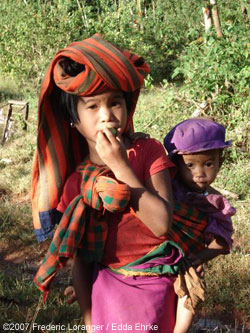 Pao Children. Photo by Edda Ehrke |
The last week of our trip was spent exploring northern Shan state, the mountain area lying east of Mandalay. We chose to travel by train, foolishly thinking it would be more comfortable than the bus. It was a marvel that this pre-war contraption managed to stay on the tracks, so much did the carriages rattle and wobble from side-to-side. Accumulating exhaustion had us relaxing in the small town of Hsipaw, soaking up the atmosphere and taking short strolls. There were all sorts of intrigues occurring around us, caused by travelers speaking about politics and the government with locals, causing concern for the police (and their spies). We spoke with a woman whose husband had recently been given 13 years in prison for attending an “anti-government” meeting (which he had actually not attended) and for guiding tourists without a license (he actually only spoke with tourists). As fascinating as this all was, we did not want to compromise the locals and so kept our interactions with them to a minimum.
Our last few days, spent in the chaotic, polluted, interesting city of Mandalay, were pretty uneventful in comparison. We visited three ancient royal cities outside the city, to see a wonderful assortment of centuries-old monasteries and pagodas. Watching the sun set from U Bein Bridge was magic. This 400-year old teak bridge crosses a lake, connecting two villages. Watching the red-robed monks and villagers walk across the bridge in the golden light of sunset was sublime. We also spent an evening watching traditional Burmese puppet theatre, an ancient and dying art form. Historically puppetry was performed during all-night “pwe” festivals, and is believed to have been the origin of traditional Burmese dance.
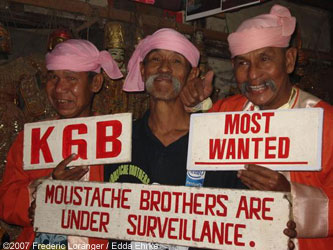 Moustache Brothers. Photo by Edda Ehrke |
A great highlight for us in Mandalay was meeting the Moustache Brothers in their humble home “theatre”. This world-renowned trio used to travel around Myanmar performing their mix of slap-stick comedy and vaudeville at village festivals and weddings. Two of them were imprisoned in the mid-90s for making politically charged jokes during an Independence Day ceremony at the house of Aung San Suu Kyi. While his brother and cousin served five years of hard labor, the third one supported the family by holding informal shows for tourists in their home. The show continues, although the Moustache Brothers are technically under house arrest. They are a very spirited trio and were quite clear about the fact that it is their fame and popularity with tourists that keeps them out of prison. Still, throughout their act, their eyes were scouting the streets outside their house for police. Their courage to continue performing despite government warnings, coupled with their charm and great goofy smiles, left an enduring impression. This was the heart of Myanmar – a really amazing people that continue to smile and have hope despite all the hardship.
Further reading
-
How to travel ethically
Ecotourism is hot. Travel companies everywhere are slapping eco-friendly labels on their tours and hotels to attract green-minded visitors. Alas some “ecotourism” is not really good for the environment or local people. That three-week round-the-world eco-tour via private jet for just $42,950 will generate a lot of greenhouse gases as you’re flying between plush lodges that import food and staff from other places. Likewise those wood carvings purchased in tourist centers may come not from indigenous artisans but a factory turning endangered rainforest hardwoods into throwaway tourist items. Heavy anchors dropped on reefs are good neither for the coral reef ecosystem nor the sustainability of the local tourism industry. So what’s a true “ecotourist” to do? Is it really possible to travel without trampling culture and tradition and further soiling the environment?
Comments
Your very readable and informative article on Myanmar (Burma) – 18 February 2007. You were right to stress the importance of thinking carefully before visiting Burma.
Three minor points on your article:
- In the 1990 Elections the NLD won just over 80% of the seats with just under 60% of all valid votes cast. I can send you the details if you are interested.
- The US imposes a virtual economic embargo on Myanmar, but not Canada or Europe. The EU “discourages” trade, investment and tourism, and also imposes selected sanctions targeted against the regime.
- Forced labour continues, as you say, but it is nowadays mostly prevalent in ethnic areas, notably those in a state of insurgency where forced portering and compulsory farm labour are serious abuses. Forced labour is rarely used on construction sites (e.g. public buildings) where the need is for skilled labour.
On balance, I take it that you feel that enlightened travel by intelligent, responsible visitors can on the whole be rewarding – the Burmese need contact with the outside world so that their misfortunes and sufferings can be better known. What Daw Aung San Suu Kyi wishes to inhibit is mass tourism to Burma at the present time and any action which might suggest that the situation in Burma is “normal” or brings any status or international respectability to the regime.
I work closely with the UK organisation “Voices for Burma” and am doing my best to persuade travel operators to carry some sober, responsible background on Burma and its problems on their websites to balance their usual sales pitch about what a wonderful country Burma is and how friendly the people are – all true, but it is only half the story.
Kind Regards,
Derek Tonkin
[retired British diplomat]